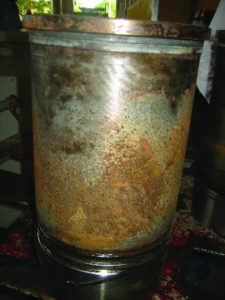 Maintenance personnel often refer to a coolant by color. If a shop has more than one bulk fluid or if formulations have been mixed, it can become a guessing game as to which coolant is used in which machine. One of the biggest issues maintenance personnel face today is coolant formulation “mixing.”
Maintenance personnel often refer to a coolant by color. If a shop has more than one bulk fluid or if formulations have been mixed, it can become a guessing game as to which coolant is used in which machine. One of the biggest issues maintenance personnel face today is coolant formulation “mixing.”
Think about it. You may use four different coolants for four different equipment manufacturers. Do maintenance personnel know the difference? You may have multiple bulk fluids. Do they understand how to maintain each coolant in each system? Do they know which one to use for top off? If not, and coolants are “mixed,” systems are left vulnerable to corrosion and cavitation – not to mention the monetary loss from too many bulk fluids in inventory.
There are more coolant formulations on the market today than ever before so how do you know which one is best for your equipment? First and foremost, the coolant you choose must meet the OEM’s coolant specifications. With engine and cooling system components manufactured globally, the resources available to make them vary by region. Therefore, coolant specifications are developed based on a fluid’s compatibility with the materials used.
Coolant formulations have also changed to accommodate the recent increases in temperature and flow rates. Today’s engine designs require coolants that can handle the load this additional heat can place on the cooling system. The Extended Life Coolant formulations have also entered the marketplace to prevent overtreatment, extend drains and reduce coolant consumption. But, only checking ELC glycol levels and keeping the system topped off is far from adequate coolant and cooling system maintenance.
Extended Life Coolants have several advantages – they’re more stable, they don’t require SCAs so overtreatment is virtually eliminated and the they have a longer service life. So why is it necessary to test Extended Life Coolants?
Mechanical issues and chemical reactions take place within the cooling system. Combustion gas leaks, air leaks, localized over – heating (hotspots) or stray electrical ground issues can chemically affect and destroy the coolant and its inhibitors. In turn, the chemically changed coolant can attack the metals and components in the system causing premature failure.
Secondly, the coolant can become contaminated due to poor maintenance practices or contaminants entering through an air leak. Contaminant pH determines if scale or acid is formed. The effects of acid formation can be corrosive wear or pitting of cooling system components, degradation of hoses and seals and inhibitor and additive depletion or dropout.
If the fluid is alkaline, contaminants can form scale which can lead to cracked heads, ring and cylinder wear which increases oil consumption or oil degradation which, in turn, increases bearing wear. A coolant cannot correct excessive contaminants that find their way into the system, whether through poor maintenance practices or a mechanical issue.
Another reason for regularly scheduled coolant analysis is coolant mixing – one of the most common cooling system maintenance issues. If mixing has occurred, more than 25% the inhibitors will be too diluted to protect the system and serious corrosion can occur. Fleets with a mix of different engine manufacturers use just as many different coolants and more often than not, maintenance personnel don’t realize the difference nor do they know the importance of topping off with the correct formulation. The costs of corrosion – related issues and having multiple coolants in use can rise quickly.
Education, regularly scheduled coolant analysis and coolant program assessments can eliminate revenue losses from unscheduled downtime. The bottom line – no matter what fluid you are using, mechanical issues and contaminants can jeopardize both engine and fluid life. Only laboratory coolant analysis can pinpoint issues before damage occurs.
